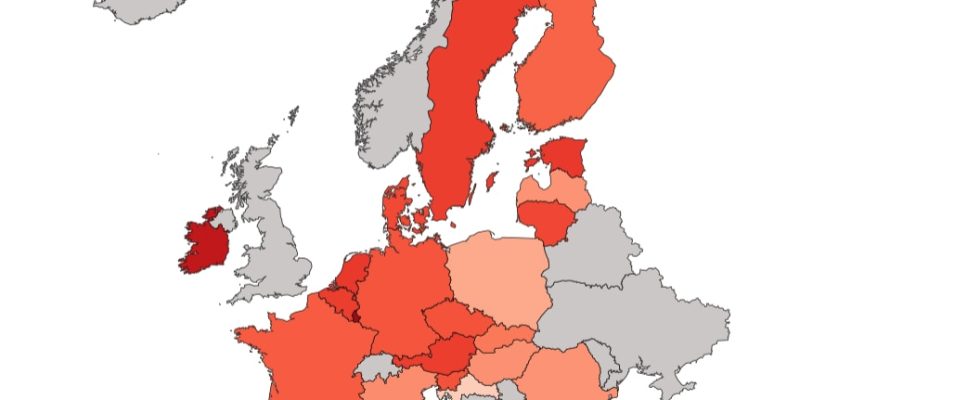The demography of the Old Continent is on the rise again. The share of inhabitants of the European Union will increase in 2022, according to new data published on Tuesday 11 July by the EU statistical office Eurostat. Although there are more deaths than births in 2022, the resurgence of migration to the EU has boosted the population. Result: the EU had 448.4 million people on 1 January 2023, compared to 446.7 million a year earlier, i.e. 1.6 million more inhabitants over one year. In other words, the biggest increase in almost 20 years.
These new data offer a boost to European demography which is running out of steam. Since 2012, the natural balance of the EU has been negative: the number of deaths exceeds the number of births. A demographic decline that has worsened after the Covid-19 pandemic. In 2020 and 2021, the Union had lost nearly 750,000 inhabitants due to the high mortality linked to the epidemic, but also to the brake imposed on migratory flows by health restrictions. Indeed, recent data allow us to draw the following conclusion: the European population would have marked a pronounced decline over the past decade if immigration had not compensated for this natural gap.
In Germany, a gain of 1.3 million inhabitants
Thus, the figures for 2022-2023 can be attributed to the influx of displaced persons from Ukraine seeking temporary protection status in the EU after the invasion of Russia in February 2022. Around four million people from Ukraine had come to seek temporary refuge in the EU in March 2023. Unsurprisingly, the European country that has taken in the most refugees is Poland with 1.5 million people having fled the Russian invasion on its territory. However, this does not prevent its demographics from falling (-3.2%) between 2019 and 2023.
In second place is Germany (just over 1 million Ukrainian refugees). German demography compensated for its decline that began in the early 2000s, by opening its doors to Syrian refugees in 2015. In 2016 alone, Berlin received more than 745,000 applications in one year. Over the past five years, Germany has even posted the strongest growth in the bloc, according to Eurostat, with a gain of 1.3 million inhabitants – followed by Spain (+1.1 million), France (+ 780,000) and the Netherlands (+529,000). The leading economic power in the EU thus confirms its status as the leading demographic power. Germans make up 19% of the total EU population.
While the demography of each country is largely influenced by political choices, the dynamics vary from one state to another. The top 3 of those recording the strongest growth between 2019 and 2023: Malta (+9.8%), Luxembourg (+7.6) and Cyprus (5.1%). Significant increases which must be analyzed with caution since these territories remain very sparsely populated. For its part, Ireland also gained inhabitants with a jump of 5.9% on the same time scale. And it’s not over: the population of the Emerald Isle is expected to increase by 18.8% respectively by 2050. For its part, France is in the soft underbelly with an increase of 1.2% .
A total of seven countries recorded a decrease in their population between January 1, 2022 and 2023, with the largest decrease reported in Italy (-179,419 people), the third most populous country in the EU. For the first time since 1861, fewer than 400,000 Italian children were born in 2022. They were 576,000 in 2008. Moreover, the proportion of people aged over 65 is the highest in Europe. Other EU members are concerned about declining birth rates, especially in central Europe. For example, Bulgarians report a 7.9% drop between 2019 and 2023. The country has the highest death rate and the lowest birth rate in Europe. In total, the fertility rate fell in 11 of the 27 EU Member States between 2001 and 2021.
The peak will be reached in 2026
Over a longer period, the European population has increased from 354.5 million in 1960 to 448.4 million on 1 January 2023, an increase of 93.9 million people. The rate of population growth has gradually slowed down over the past decades. In Europe, could immigration reverse the trend? The demographic future for European countries should rather be in decline from 2026, predicts Eurostat. According to data from the agency, the population of the European Union should increase to 453.2 million in 2026 (+1.5%), before slowly decreasing.
The demographic shock can be explained by several factors, such as the strong aging of the population. The share of the working population is expected to decline significantly, while people aged 65 should be more numerous due to an increase in life expectancy. While the peak of 8 billion inhabitants on Earth was exceeded at the end of 2022, European demographic dynamics risk taking the opposite path.
